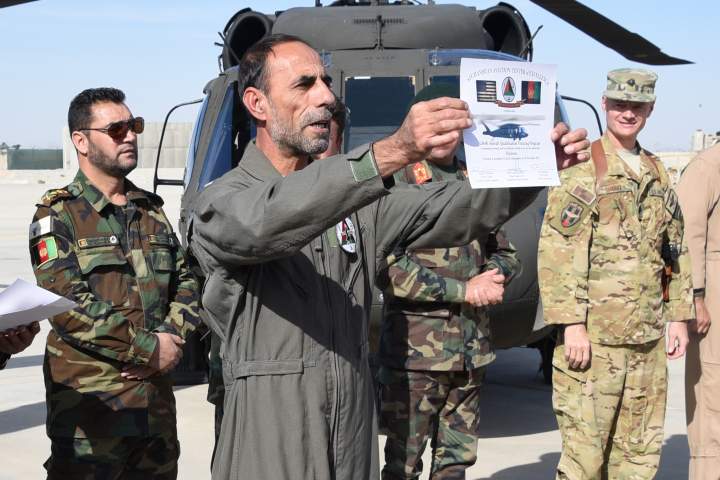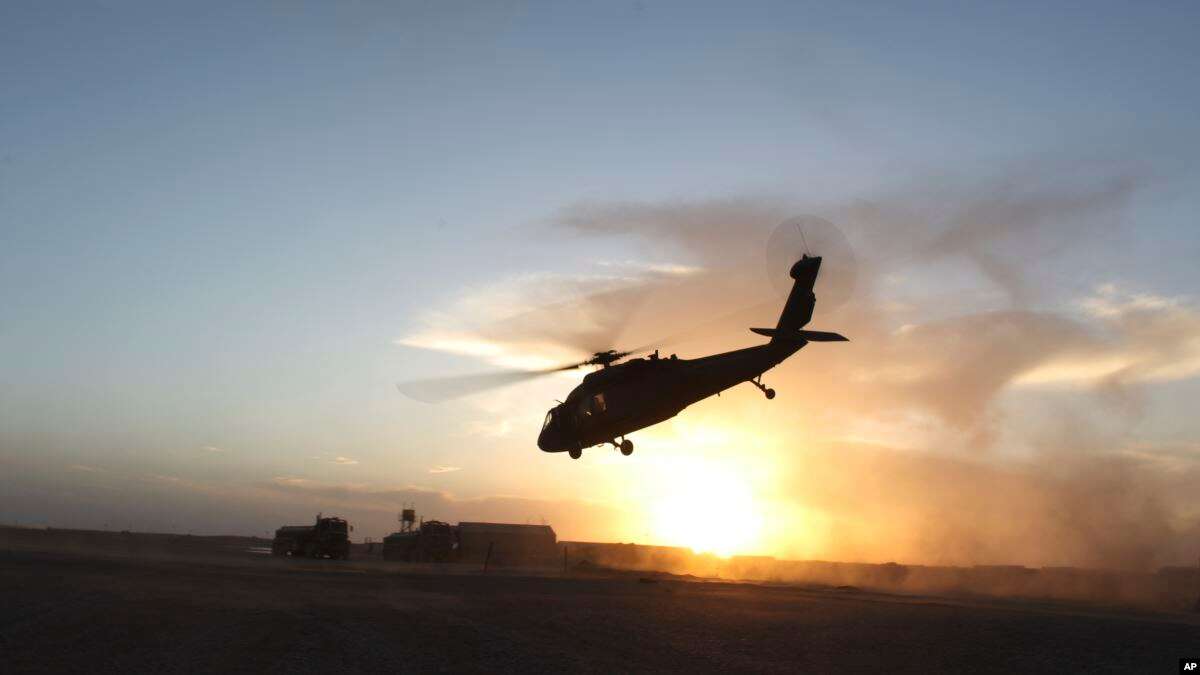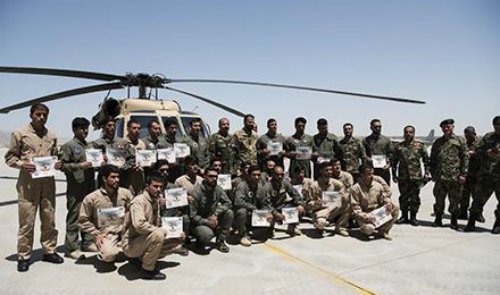The Afghan Air Force carried out its first airstrike with smart bombs on March 2018.
Publish dateTuesday 9 April 2019 - 22:34
Story Code : 182980
AVA- The Afghan pilot did this in one of the new A-29 aircraft the air force had recently received. By the end of 2018 Afghan pilots were doing it at night and by March 2019 were carrying out at least a dozen of these night smart bomb attacks a month. With a growing number of Afghan pilots trained to use smart bombs, the Taliban have had to change their tactics in areas where the Afghan Air Force provides most of the air support. The A-29s use a 250 pound (113 kg) bomb with an added Paveway laser guidance kit. This enables the Afghan pilots to attack Taliban forces safely when they are close to friendly forces or civilians. By using the laser-guided, instead of GPS guided bomb, the pilot has to see the target and uses the aircraft laser designator to mark the target location for the bomb to hit. After proving they can do this in daylight and have qualified for night flights, the Afghan pilots tend to become effective at night attacks very quickly. Currently, a dozen A-29s are equipped to carry out night bombing missions with the rest of the 19 A-29s used for training and reconnaissance.
Afghanistan began receiving the first eight (of twenty) A-29 trainer/attack aircraft in early 2016. Afghan pilots flew over a thousand sorties in these A-29s by the end of 2016, mostly for training and reconnaissance. The first attack sortie was carried out in April 2016. At about the same time Afghan pilots and maintainers managed to carry out a surge operation and enable A-29s to carry out 83 sorties in 24 hours. This was an important achievement for the maintainers, who have to be pretty good to “surge” and carry out that many sorties in one day. All twenty A-29s had arrived by 2018 although one has since been lost in an accident. The first eight Afghan pilots completed their training (in the United States) in late 2015 and additional A-29 pilot training now takes place in Afghanistan.
The A-29 Super Tucano is a single engine turbo-prop trainer/attack aircraft that is used by over a dozen nations. This aircraft carries two internal 12.7mm (.50 caliber) machine-guns. A 20mm autocannon is carried under the fuselage along with about a tons of bombs and rockets under the wings. It can stay in the air for 6.5 hours at a time. This aircraft can be equipped to carry over a half dozen of the GBU-28 smart bombs (or half a dozen dumb 500 pound bombs), giving it considerable firepower. The Super Tucano comes equipped with a GPS guidance system. Max altitude is 11,300 meters (35,000 feet) and cruising speed is 400 kilometers an hour.
Naturally, this aircraft can move in lower and slower than any jet can making it more effective for ground support. The Super Tucano is also equipped with armour for the pilot, a pressurized cockpit, and an ejection seat. Not bad for an aircraft with a max takeoff weight of 5.4 tons. It is rugged, easy to maintain, and cheap. The U.S. is paying about $20 million for each Afghan Super Tucano, which includes training, spare parts, and support equipment. Afghanistan already has hundreds of pilots who could quickly learn how to handle the Super Tucano and the U.S. will provide training for over a hundred pilots and maintainers.
The A-29 is not the only attack aircraft the Afghans have. In 2014 the U.S. agreed to provide Afghanistan with 62 more armed helicopters as well as the A-29s, including training for Afghan pilots and maintainers, by 2017. The helicopters are the MD-530F, which is the civilian version of the U.S. SOCOM (Special Operations Command) MH-6. Used for scouting and commando operations the MH-6 (and the similar AH-6) were developed from the 1960s era OH-6. Developed in the early 1980s, the MH/AH-6, or "Little Bird" is a 1.4 ton helicopter with a crew of two, top speed of 280 kilometers an hour. Average sortie is 3-3.5 hours. It can be armed with two 7.62mm or 12.7mm machine-gun pods, or two 70mm rocket pods (seven or 12 rockets each) or four Hellfire missiles. Without weapons, the MH-6 can carry six troops (usually Special Forces operators) externally. The MH-6 has an endurance of about 90 minutes as it usually carries a full load of weapons or passengers. The new MH-6 can also carry a day/night targeting system, including a laser designator and laser-guided missiles.
In mid-2017 the United States decided to pay for a major expansion of the Afghan Air Force and that led, in September, to an order for 150 MD-530F armed helicopters for about $9.25 million each. This includes delivery, pilot and maintainer training, maintenance equipment, spare parts and tech support. With the new order for MD-530Fs the size of the Afghan helicopter force will get faster sooner because the 150 new MD-530Fs will all arrive by 2022. The MD-530Fs used for ground attack only operate during the day. They are vulnerable to ground fire because they have to come in low to use machine-guns and rockets. The MD-530F also provide ground commanders with timely information about where the enemy is and what they are up to. The Taliban fear the MD-530Fs mainly because they not only report Taliban locations but can attack as well.
A major advance for the Afghan Air Force was training enough maintainers and weapons specialists who could not only add the guidance kits to the unguided bombs but quickly attach them to the A-29s.
Afghanistan began receiving the first eight (of twenty) A-29 trainer/attack aircraft in early 2016. Afghan pilots flew over a thousand sorties in these A-29s by the end of 2016, mostly for training and reconnaissance. The first attack sortie was carried out in April 2016. At about the same time Afghan pilots and maintainers managed to carry out a surge operation and enable A-29s to carry out 83 sorties in 24 hours. This was an important achievement for the maintainers, who have to be pretty good to “surge” and carry out that many sorties in one day. All twenty A-29s had arrived by 2018 although one has since been lost in an accident. The first eight Afghan pilots completed their training (in the United States) in late 2015 and additional A-29 pilot training now takes place in Afghanistan.
The A-29 Super Tucano is a single engine turbo-prop trainer/attack aircraft that is used by over a dozen nations. This aircraft carries two internal 12.7mm (.50 caliber) machine-guns. A 20mm autocannon is carried under the fuselage along with about a tons of bombs and rockets under the wings. It can stay in the air for 6.5 hours at a time. This aircraft can be equipped to carry over a half dozen of the GBU-28 smart bombs (or half a dozen dumb 500 pound bombs), giving it considerable firepower. The Super Tucano comes equipped with a GPS guidance system. Max altitude is 11,300 meters (35,000 feet) and cruising speed is 400 kilometers an hour.
Naturally, this aircraft can move in lower and slower than any jet can making it more effective for ground support. The Super Tucano is also equipped with armour for the pilot, a pressurized cockpit, and an ejection seat. Not bad for an aircraft with a max takeoff weight of 5.4 tons. It is rugged, easy to maintain, and cheap. The U.S. is paying about $20 million for each Afghan Super Tucano, which includes training, spare parts, and support equipment. Afghanistan already has hundreds of pilots who could quickly learn how to handle the Super Tucano and the U.S. will provide training for over a hundred pilots and maintainers.
The A-29 is not the only attack aircraft the Afghans have. In 2014 the U.S. agreed to provide Afghanistan with 62 more armed helicopters as well as the A-29s, including training for Afghan pilots and maintainers, by 2017. The helicopters are the MD-530F, which is the civilian version of the U.S. SOCOM (Special Operations Command) MH-6. Used for scouting and commando operations the MH-6 (and the similar AH-6) were developed from the 1960s era OH-6. Developed in the early 1980s, the MH/AH-6, or "Little Bird" is a 1.4 ton helicopter with a crew of two, top speed of 280 kilometers an hour. Average sortie is 3-3.5 hours. It can be armed with two 7.62mm or 12.7mm machine-gun pods, or two 70mm rocket pods (seven or 12 rockets each) or four Hellfire missiles. Without weapons, the MH-6 can carry six troops (usually Special Forces operators) externally. The MH-6 has an endurance of about 90 minutes as it usually carries a full load of weapons or passengers. The new MH-6 can also carry a day/night targeting system, including a laser designator and laser-guided missiles.
In mid-2017 the United States decided to pay for a major expansion of the Afghan Air Force and that led, in September, to an order for 150 MD-530F armed helicopters for about $9.25 million each. This includes delivery, pilot and maintainer training, maintenance equipment, spare parts and tech support. With the new order for MD-530Fs the size of the Afghan helicopter force will get faster sooner because the 150 new MD-530Fs will all arrive by 2022. The MD-530Fs used for ground attack only operate during the day. They are vulnerable to ground fire because they have to come in low to use machine-guns and rockets. The MD-530F also provide ground commanders with timely information about where the enemy is and what they are up to. The Taliban fear the MD-530Fs mainly because they not only report Taliban locations but can attack as well.
A major advance for the Afghan Air Force was training enough maintainers and weapons specialists who could not only add the guidance kits to the unguided bombs but quickly attach them to the A-29s.
avapress.net/vdch6inzv23n6wd.01t2.html
Tags
Top hits












